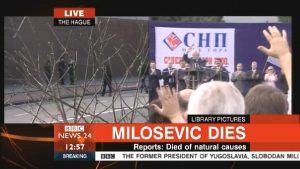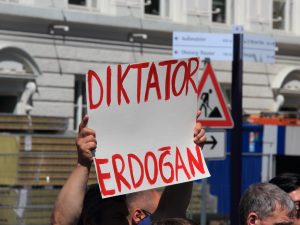Minds of the Movement
An ICNC blog on the people and power of civil resistance
by Tom HastingsApril 20, 2021
In our best civil resistance literature on pillars of support, we learn that an autocrat needs the allegiance of religious leaders, security forces, business elites, media, bureaucrats, educational institutions, and other sectors of society in order to appear and function as an all-powerful controlling figure.
Therefore, we teach and train toward impacting the subsystem. How can we engender loyalty shifts away from the autocrat and toward a free or democratic alternative? We think about multipronged efforts that pressure and appeal to key groups that directly or indirectly support an oppressive system.
However, those of us who study and practice civil resistance need to know that the Academy for Autocrats is also busy learning—in many cases, from us. We share our knowledge in the spirit of offering tools for nonviolent liberation to all, everywhere. There are strengths in our transparency and open approach, but autocrats also try to use this to their advantage, seeking to think several moves ahead of activists.

Milošević's was indicted in May 1999 by the International Criminal Tribunal for the Former Yugoslavia for crimes against humanity in Kosovo. He died in prison in 2006. Source: Nathan Collins (CC BY-NC-SA 2.0, unedited).
Autocrats also learn when they see dictatorships elsewhere fall (as in the first case below) or, conversely, when dictators forge full-steam ahead, shrewdly foiling resistance (as in the second case below).
At the turn of the 21st century, Slobodan Milošević didn’t bother to campaign for re-election, but nonviolent dissidents did—for his removal and for the establishment of democracy and rule of law—all over the country. This produced a landslide election against Milošević, and the result was defended by popular civil resistance. Milošević eventually died in prison, on trial in the Hague for his crimes against humanity.
On the other hand, Turkey’s President Recep Tayyip Erdoğan, far more authoritarian than democratic, resisted and defeated both civil resistance and a coup attempt. His regime did at least two key things that foiled civil resisters. One, they disrupted social media and blunted mobilization dependent on it. Two, they learned that, while social media organizing can produce apparently explosive people power, it is poor at both generating momentum and engendering long-haul, resilient commitment compared to traditional “shoe leather, potluck dinner meeting” organizing.

Source: Wikipedia/Rasande Tyskar (CC BY 2.0, unedited).
Some readers may be asking themselves what the world’s authoritarians learned from recent developments in the United States, where autocratically inclined leaders and their allies have also attacked democracy. We’ve seen normalizing of hateful and anti-democratic rhetoric. We’ve also seen signaling to people in various pillars that they will be kept in privilege and immunity if they engage in corruption or seek to subvert accountability. In part as a result, on January 6, 2021, some police wavered from defending the U.S. Capitol, and some security forces came in plain clothes to participate in the assault. These subsystems continue roiling in the background in the United States. It is perhaps cases like the U.S. one that embolden the world’s aspirational autocrats. Time will tell.
Thinking about both rising autocrats and extant dictators, we can imagine how they have learned from the mistakes and miscalculations of their authoritarian brethren since the rise of people power. They’ve perhaps even benefited from the dissemination of educational resources and research findings that serve civil resisters. In a sense, it’s not that they have taken a page from our playbook; we have given the entire playbook to them.
What is the lesson?
Secrecy, stealth, hidden underground communications? Operating much more in the shadows? Stop publishing helpful methods and tactical information and findings?
Clearly, no. That is no way to foster faith in civil resistance. But I can offer a few recommendations for a calculated way forward:
Continue to learn and devise...
...new nonviolent methods to circumvent and thwart dictators—methods that get ahead of their learning. Information is power.
Innovate new methods...
...of synthesizing social media and traditional in-person connection, such as associating hashtag campaigns with a particular offline action that ratchets up pressure on traditional powerholders. This fosters both quick mobilization and long-term commitment and resilience.
Shore up...
...existing broad-based, long-lived civil society organizations such as the Association for Women’s Rights in Development (AWID) and Front Line Defenders so there are both quick-response and long-enduring capacities for movements in times of repression.
Develop new methods...
...to inoculate against false flag operations and other damage done by agents provocateurs (ed: see here for a new, expanded repertoire of nonviolent tactics published by ICNC Press). Do so not by internal hyper-security but rather by increased transparency, gentle personalism (relational development and upkeeping), and a renewed, open, public commitment to absolute nonviolent discipline.
~
Like warfare, which has throughout the ages been a race to develop new shields to defend against swords to better penetrate old and new shields, the science and craft of nonviolent resistance can reverse the trend toward autocracy at home and abroad if we buck up and buckle down. This will take all of us and will take all our creativity and commitment.

Tom Hastings
Tom H. Hastings, long-time ICNC collaborator, is Coördinator of Conflict Resolution BA/BS degree programs and certificates at Portland State University (USA), PeaceVoice Senior Editor and on occasion an expert witness for the defense of civil resisters in court. He has written several books and many articles about nonviolence and other peace and conflict topics. He is a two-time Plowshares resister and a founding member of two Catholic Worker communities.
Read More